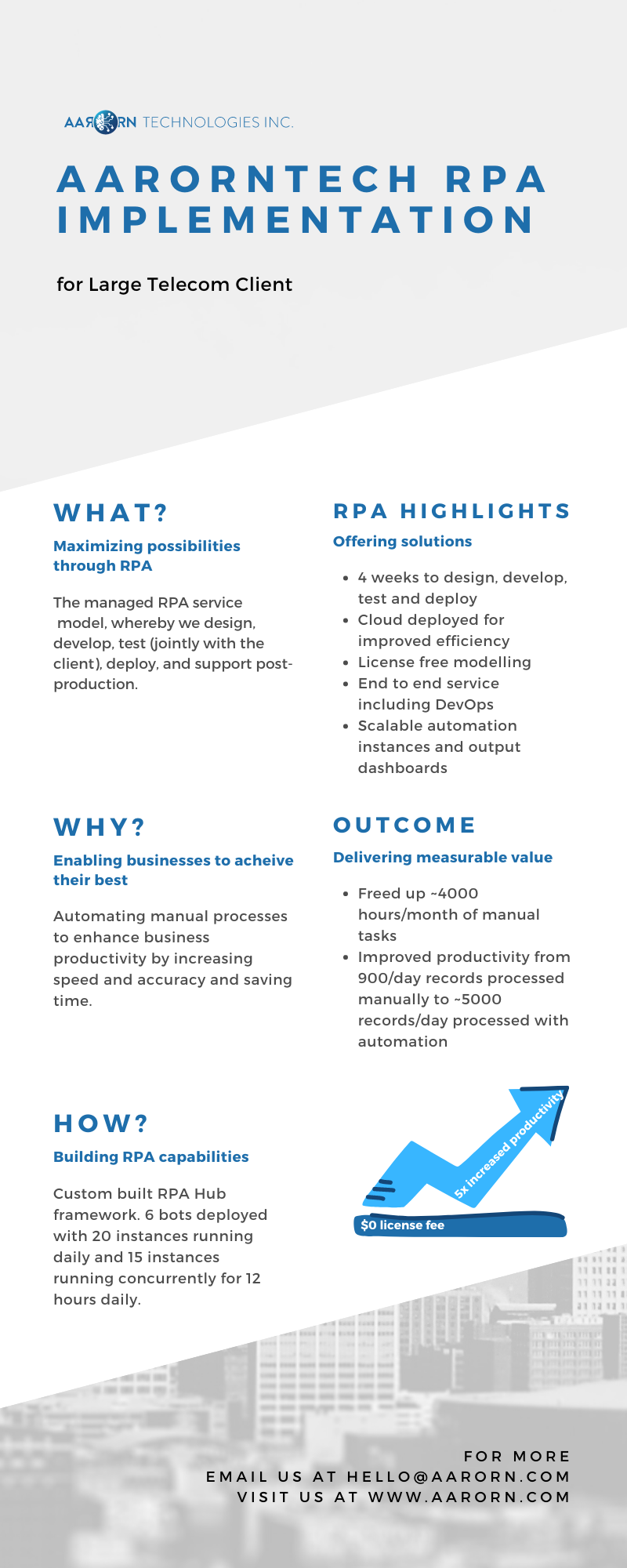Document Management
In the age of knowledge, the information adds value to a firm. Yet, organizations struggle to extract the necessary information, and eventually, most of it ends up being dark data due to the lack of the ability to elicit beneficial information. Any piece of valuable information comes along with unnecessary details. Extricating significant portions from other specifics is a challenge that businesses face every day. How does a company then filter this beneficial information and store it in a way that is most accessible and yet efficient in managing the storage costs? The answer lies with the Robotic Process Technology (RPA).
RPA has found its use across business processes, especially in Document Management, i.e., the organization and storage of documents. While there are various ways of managing documents, RPA has thus far been the most efficient one. As long as a process is automatable, RPA finds its use. Documentation entails repetitive tasks, and automating these processes makes accessibility easier and reduces storage costs substantially. RPA and Artificial Intelligence (AI) add the benefit of learning over time to a Document Management process. The software can identify complex problems, such as when the bills have not been paid. It can also eliminate old or irrelevant records and hence streamline the processes. RPA with the AI system can learn to understand documents and use predictive decision making.
Document processing comprises of various activities. Document identification is the process that enables the software to identify the type of the document, such as a machine-readable text form or handwritten and scanned document or an image. Every organization handles hundreds of reports each day that are in various formats. Some materials are in standard formats such as tax forms, immigration forms, etc., typically regulatory and compliance records. These documents are associated with the processes that are repetitive and can be easily automated. RPA can help organizations read, classify, and store these forms into structured data systems. Other documents may contain data embedded in the free text, such as paragraphs and bullet points such as legal bills and medical coding. The RPA tools, along with APIs such as OCR tools, can help extract them and eventually retrieve them to a more accessible and usable system. The RPA tools combined with OCR tools and Natural Language Processing (NPL) algorithms can achieve superior readability irrespective of the context and format with greater accuracy as they evolve.
Once the tools identify the data, it needs to be classified based on its function, such as invoices, trade bills, timecards, etc. After the classification of documents, the relevant information needs to be read and interpreted. Actions need to be performed based on conclusions such as data storage and actions like sending notifications.
Data management using RPA and other intelligent tools enables organizations to improve efficiency and accuracy and reduce workloads and costs. Since each organization deals with a plethora of data on any given day, processing, analyzing, extracting, validating, and storing may take over the human workforce’s time. RPA provides a feasible option for manual data handling and processing of inbound documents.
Organizations are using data to enhance customer experience, improve employee and process productivity, and enter new markets. Document Management helps businesses achieve a competitive advantage through higher efficiency. Using information to provide analytics is made possible with bots taking over the repetitive tasks previously performed manually. To carry out any beneficial analysis, the automation of document processing has become critical.
RPA manages massive amounts of data from virtually any internal or external system. It helps organizations manage repetitive and labor-intensive tasks, switch data between applications conveniently, trouble-free downloading and uploading of files, effortless analysis and extraction of data, and prevention of frauds through easy monitoring of data, users and activities. And eventually, Document Management with RPA allows businesses to do green.
Chatbots
A chatbot is a conversational software that has become commonplace, whether you open a website or call customer service. It is a bot that chats like humans, i.e., it mimics human capacity to comprehend languages with increasing accuracy as they evolve. Chatbots can understand and interpret both written and spoken text. It is a software that typically carries out automated tasks or performs a workflow. Chatbots’ role to completely replace human intervention is arguable. However, their increasing popularity makes it pertinent to understand their position in today’s business world.
What makes Chatbots so widespread is the way they seamlessly integrate with existing systems. Bots are finding their uses in broader platforms and are expected to make interactions with software easier. Chatbots are used in messaging applications, websites, mobile apps, and through the telephone. The majority of the existing solutions can be added to the bot framework without hassle.
There are mainly two categories of chatbots. Command based chatbots can answer a fairly reasonable number of typical questions. However, for any nonconforming requests, human intervention is required. Command based chatbots use template search or dynamic search to understand questions. Their ability is conditional on the scope of the programming. On the other hand, AI-based chatbots learn continuously, depending on the inputs they receive. Once a thing in movies, we have Artificial Intelligence in chatbots, where humans and machines interact through natural languages. Machine learning enables these bots to learn from human conversations and use that information to provide better responses in the future. AI chatbots use artificial intelligence to establish the users’ intent and return a predetermined response that may include text, pictures, external links, videos, or product recommendations. These chatbots can be used in various contexts, from sentiment analysis to determining the likelihood of the purpose of visits on a website.
Chatbots have led to enhanced customer service. Without waiting for the call center agent’s response, a chatbot can handle various queries around the clock. Instead of long lists of FAQs, customers find it convenient that chatbots return answers to specific FAQs. Chatbots also make online shopping an exceptional experience. Chatbots remember the preferences and use the information for subsequent visits. Personalized communication with chatbots stimulates the customer’s desire to purchase. The speed of processing customers’ requests helps gain their satisfaction and loyalty.
One of the primary uses of chatbots in a business is that of lead generation. Using a conversational approach to marketing, organizations engage lead generation bots to identify potential customers, generate their interest, and foster rapport with the prospects. According to a survey cited in Chatbots Magazine, 67% of the respondents expressed a higher likelihood of purchasing products and services from businesses using a chatbot. Lead generation bots ensure that a visitor is attended 24/7 and receives a timely response. Furthermore, visitors are more comfortable talking to chatbots in this scenario to avoid potential hard-selling exposure. Therefore, lead generation chatbots are the perfect way to automate sales and lead generation processes by turning prospects into leads across client websites and platforms on social media.
Besides, businesses use chatbots to get rid of routine tasks and instantaneously process multiple requests. While many customer queries remain unanswered, or at best get a late response due to bogged down agents, chatbots respond to 100% of messages irrespective of the time of a day or a week. There is substantial evidence based on the trend in sales statistics suggesting that the businesses that use conversational software will be at an advantage over those that don’t.
A combination of chatbots and live chat offers entirety to a communication process in various scenarios. Chatbots help users with search, leaving contact information, or suggesting products and services. However, live chat is preferred when an existing customer wants to register a complaint, or a potential customer needs to derive a price based on certain exemptions. To avoid undue back and forth of messaging, live agents may resolve the issue and improve customer experience. Furthermore, it is cost-effective to live chat with a customer compared to phone support. Live chat agents can share information on various media and multitask that isn’t possible over the phone. Nevertheless, implementing live chat to substitute phone support can improve operational efficiency and overcome chatbots’ limitations when human intervention is essential.
RPA for Public Sector
The demands of the public sector are higher than ever, and the governments face severe constraints. Cutting costs means efficiency in good times and a necessity during harder times. Nevertheless, cost efficiency is one of the key objectives of all governments. Yet many such projects fail due to the wrong approach, i.e., reducing costs less likely to sustain the intended cost reductions. In other words, governments tend to reduce budgets in ways that are not sustainable. Governments have started leveraging on smarter means for managing public sector expenditures. These are permanent solutions that help in cutting costs without compromising on the quality. Robotic Process Automation (RPA) is an intelligent approach to help realize public sector efficiency in terms of cost and quality.
In the past, the public sector has been either slow or unable to adopt digital transformation. Recently, governments have shown more adaptability towards technology, and RPA is one way that aided this trend. While RPA brings enormous benefits through automation of processes typically run every day in public sector agencies, it is a non-invasive technology that is convenient to adopt and can be introduced in phases. Since RPA doesn’t have to be operated to an end-to-end process, it enables large departments to automate sub-processes seamlessly, with low costs and minimal disruptions. Accordingly, RPA closes the gap between novel technologies and legacy systems in the public sector.
RPA is a rules-driven technology that does not require any human judgment. It takes care of all the repetitive tasks that involve data manipulation and data migration. All the data-intensive processes that have a high error rate, include sensitive information, and are electronically triggered are the potential candidates for RPA. Governments generally depend on massive databases that involve a large number of transactional activities. Public sector workers dedicate a substantial portion of their workdays in such operating tasks as collecting, cleaning, and reorganizing data. Consequently, the workforce has less time to assign more germane roles that entail data integration and analysis. Implementing RPA has been recognized by various public sector domains such as healthcare, education, police, central government, local government, to name a few. A significant amount of use cases in these sectors are a testimony for other countries to consider.
The central governments can automate universal credit and benefit calculations, tax calculations, and licensing application processing. All these functions are data-intensive, involve mundane but necessary handling of data, and cannot afford errors. For local governments, RPA can be used to automate processes related to revenue collection, permit applications, and incident reporting to highlight a few. The new machinery of government: Robotic Process Automation in Public Sector by Deloitte LLP underscores the use cases in public sectors and reports an increase in throughput and ROI and reduced costs as the primary outcomes. Nonetheless, RPA brings many benefits to the public sector and a smart approach towards digital transformation.
To summarize, RPA can handle complex tasks with speed. RPA enables optimization of data collection, consolidation, and indexing to set up all processes with accurate information. It also introduces accuracy to payments and distribution as RPA returns results that are consistently error-free. Through automation, RPA enables smoother and quicker delivery of services and enhance service levels. Automating repetitive tasks helps the public sector improve their operations, reduce costs, and improve citizens’ service. Employees appreciate the benefits of RPA as it relieves them from mundane activities to focus on more value-adding projects and serve the citizen. Public sectors that have adopted RPA find the functioning least disruptive during crises such as the present Covid-19. With fewer employees at work, bots perform tasks 24/7, can be remotely accessed, and mitigate the majority of the risks associated with shutdowns. For these reasons, RPA is envisioned as a critical driver towards digital transformation in the public sector.





